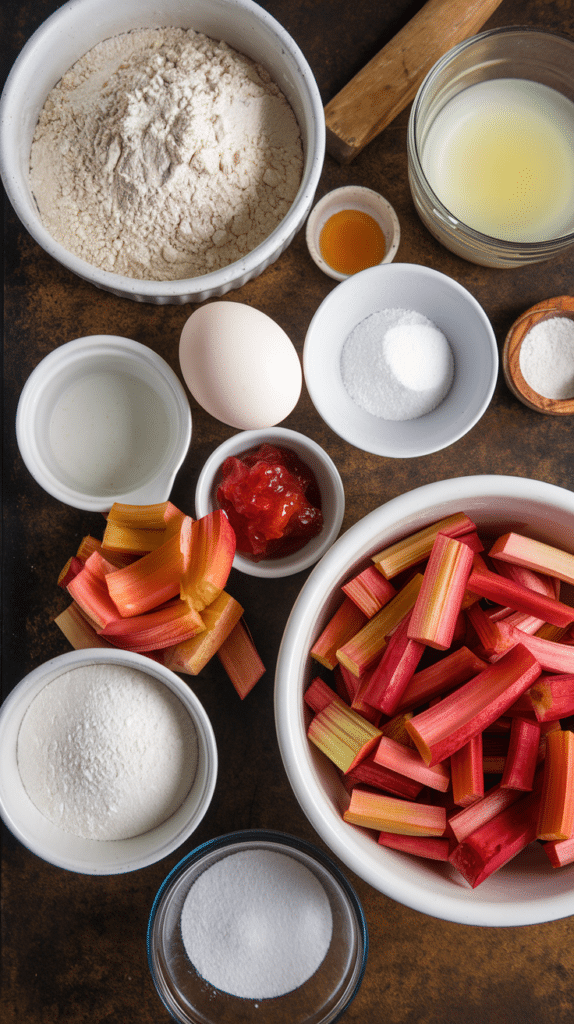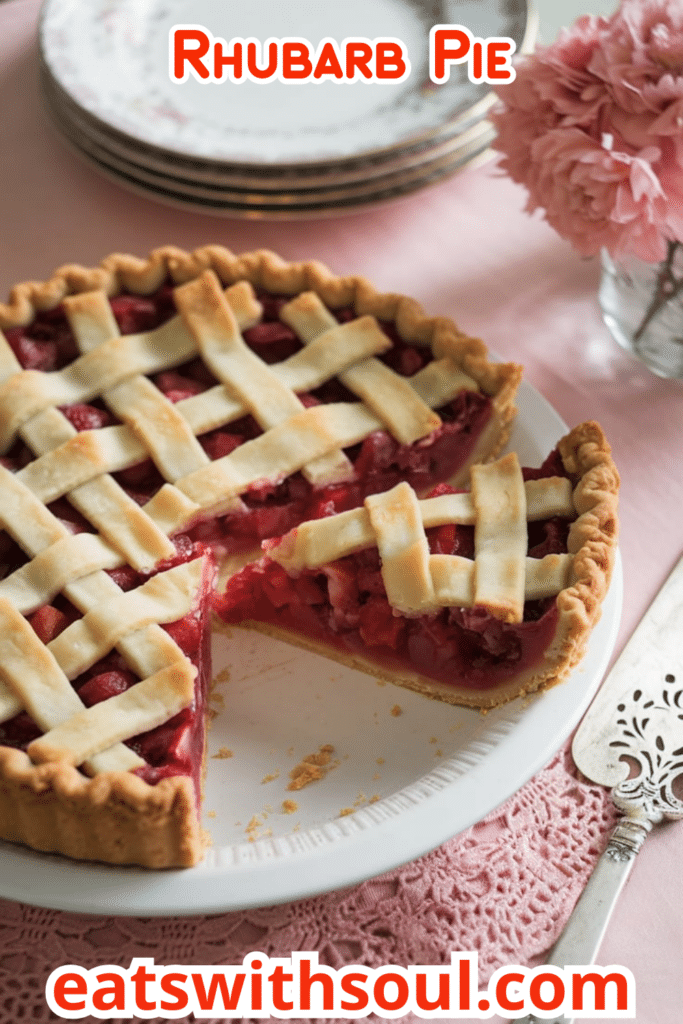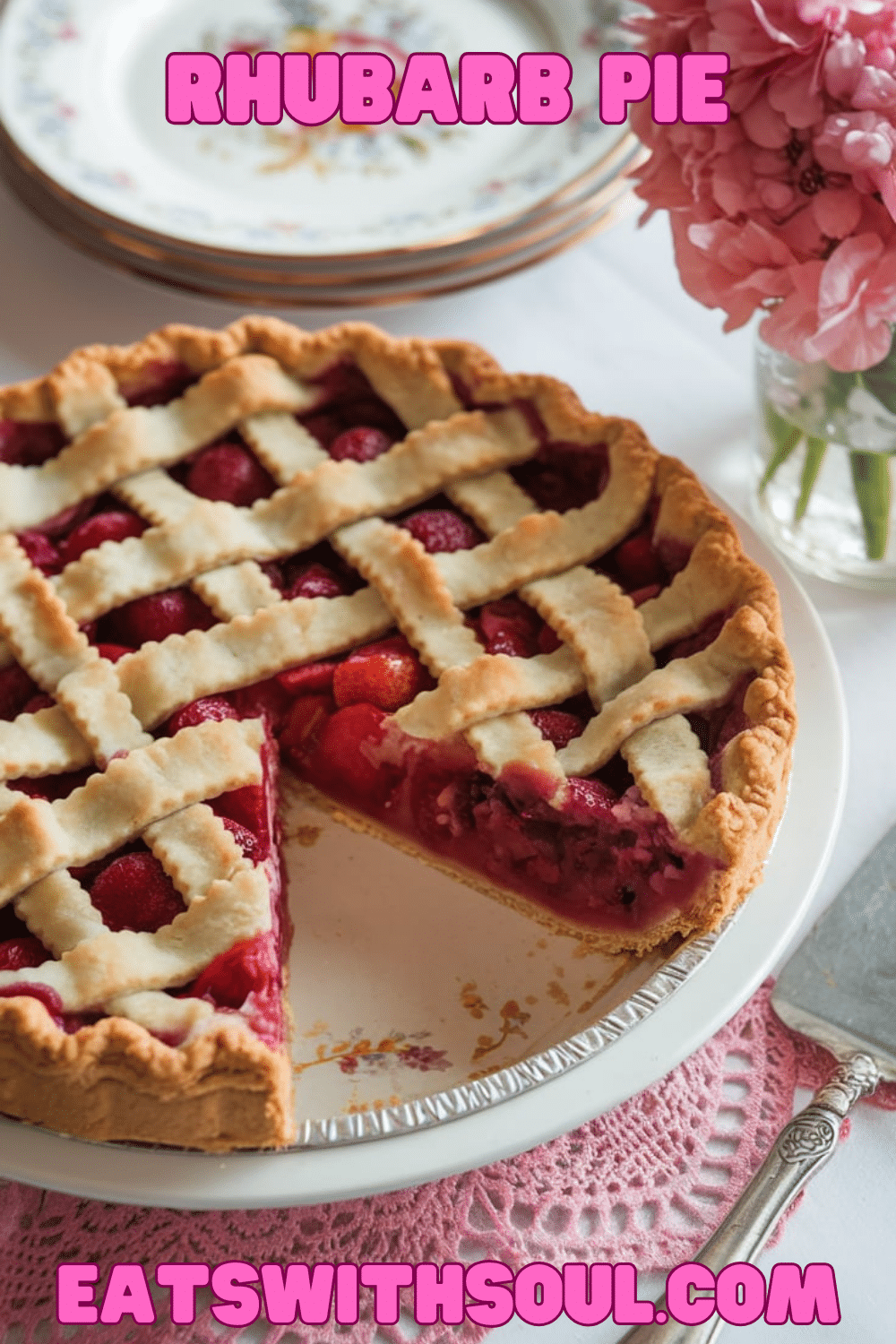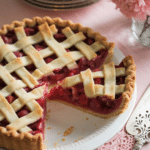Introduction & Inspiration
Rhubarb pie is a quintessential spring dessert, a celebration of the tart, vibrant stalks that signal the arrival of warmer weather. The contrast between the tender, sweet-tart filling and the flaky, buttery crust is simply irresistible.
My inspiration for this recipe comes from a love of classic, old-fashioned pies. I wanted to create a Rhubarb Pie that was both delicious and visually appealing, with a beautiful lattice top that showcases the vibrant filling. It is my favorite pie.
This pie is perfect for a spring gathering, a weekend baking project, or any time you crave a taste of homemade goodness. It’s a comforting and satisfying dessert that’s sure to impress.
A perfect recipe to welcome spring.
Nostalgic Appeal
Rhubarb pie has a strong nostalgic appeal for many. It’s a dessert that often evokes memories of grandmothers’ kitchens, family gatherings, and simpler times. The tart flavor of rhubarb is unique and memorable.
The lattice top adds a touch of old-fashioned charm, making this pie a beautiful centerpiece for any table. It’s a dessert that’s both rustic and elegant, a perfect blend of comfort and sophistication.
This recipe aims to capture that nostalgic appeal while providing clear, step-by-step instructions for making a truly exceptional pie from scratch. It’s a way to connect with culinary traditions and create new memories.
A perfect recipe, to bake something special.
Homemade Focus
As always, I’m a passionate advocate for homemade baking. While store-bought pies and fillings might offer convenience, they simply can’t compare to the flavor and texture of a pie made entirely from scratch.
This Rhubarb Pie is a testament to that philosophy. We’re making the crust from scratch, using simple ingredients and a straightforward technique. The filling is made with fresh rhubarb, carefully balanced with sugar and spices.
Making each component yourself allows you to control the quality of the ingredients and ensure that every element is perfectly balanced. It’s a labor of love, but the results are well worth the effort. A delicious pie.
This recipe showcase perfectly, that baking is rewarding.
Flavor Goal
The primary flavor goal for this Rhubarb Pie is a delightful balance of sweet and tart. The rhubarb, with its natural tanginess, is the star of the show. It should be tender but not mushy, with a vibrant flavor that’s both refreshing and satisfying.
The sugar in the filling balances the tartness of the rhubarb, creating a perfectly sweet-tart combination. The apricot jam adds a subtle sweetness and helps to create a beautiful, glossy filling.
The crust should be flaky and buttery, providing a perfect textural contrast to the soft filling. The overall effect is a pie that’s both comforting and invigorating, a perfect celebration of spring flavors. The taste is incredible.
Ingredient Insights
For the Crust:
- All-Purpose Flour: Provides the structure for the crust. I use unbleached all-purpose flour.
- Vegetable Shortening: Creates a flaky, tender crust. While I prefer an all-butter crust for some pies, shortening is traditionally used in rhubarb pie for its ability to create a particularly tender and flaky crust. You can substitute with butter if you prefer.
- Large Egg: Adds richness and helps to bind the dough together.
- Cold Water: Hydrates the flour and helps to create a cohesive dough. The water should be very cold to prevent the shortening from melting.
- Distilled White Vinegar: A secret ingredient that helps to tenderize the gluten in the flour, resulting in a more tender crust.
- Kosher Salt: Enhances the other flavors and balances the sweetness.
For the Filling:
- Fresh Rhubarb: The star of the show! Use fresh, firm rhubarb stalks for the best flavor and texture.
- Apricot Jam: Adds a subtle sweetness and helps to create a beautiful, glossy filling. It also complements the flavor of the rhubarb.
- Vanilla Extract: Enhances the other flavors and adds a touch of warmth.
- Kosher Salt: Balances the sweetness and enhances the other flavors.
- Granulated Sugar: Sweetens the filling and balances the tartness of the rhubarb.
- Cornstarch: Thickens the filling, creating a smooth, cohesive texture.
- Heavy Cream
Essential Equipment
- Large Bowl: For mixing the crust ingredients and the filling ingredients.
- Pastry Cutter or Two Knives: For cutting the shortening into the flour.
- Small Bowl: For beating the egg.
- Rolling Pin: For rolling out the pie dough.
- 9-Inch Pie Plate: A standard 9-inch pie plate is perfect for this recipe.
- Fork:
- Foil-Lined Baking Sheet: To catch any drips from the pie during baking.
Ingredients
For the Crust:
- 3 cups all-purpose flour, plus more for dusting
- 1 1/2 cups vegetable shortening
- 1 large egg
- 5 Tbsp. cold water
- 1 Tbsp. distilled white vinegar
- 1 tsp. kosher salt
For the Filling:
- 6 cups sliced fresh rhubarb
- 2 Tbsp. apricot jam
- 1 tsp. vanilla extract
- 1/2 tsp. kosher salt
- 1 1/4 cups sugar, plus more for sprinkling
- 6 Tbsp. cornstarch
- 1 Tbsp. heavy cream

Step-by-Step Instructions
1. Make the Crust Dough:
- Put the flour in a large bowl.
- Gradually work in the shortening with a pastry cutter or two knives until the mixture resembles coarse meal.
- Beat the egg with a fork in a small bowl.
- Pour the egg into the flour mixture.
- Add the cold water, vinegar, and salt.
- Stir until all the ingredients are combined.
2. Chill the Dough:
- Divide the dough in half.
- Form into two balls.
- Place each ball in a large resealable plastic bag.
- Using a rolling pin, slightly flatten each ball of dough.
- Seal the bags and place them in the freezer for 15 to 20 minutes to chill.
3. Prepare the Filling:
- Meanwhile, in a large bowl, toss the sliced rhubarb with the apricot jam, vanilla extract, and salt.
- Whisk the sugar and cornstarch together in a small bowl.
- Add the sugar mixture to the rhubarb and mix well. Set aside.
4. Preheat and Prepare the Bottom Crust:
- Position a rack in the lower third of the oven and preheat to 425°F (220°C).
- Roll out one piece of dough into a 12-inch round on a lightly floured surface.
- Place the dough in a 9-inch pie plate. Do not trim the excess dough yet.
5. Add the Filling:
- Pour the rhubarb mixture into the pie plate and spread it evenly.
6. Prepare the Lattice Top:
- Roll out the second piece of dough into a 12-inch round.
- Cut the dough into 12 even strips.
- Lay 6 strips across the top of the pie, evenly spaced.
- Gently fold back every other strip halfway.
- Lay another strip of dough on the pie over the unfolded ones, perpendicular to them.
- Unfold the strips so they lie over the perpendicular one.
- Fold back the strips that haven’t been folded yet and add another perpendicular strip.
- Unfold the strips over it.
- Repeat the folding and unfolding process until you have a lattice. If the dough strips tear, gently press them back together.
7. Trim and Crimp the Edges:
- Trim the ends of the lattice strips.
- Fold the overhanging bottom crust up and over the lattice strips.
- Trim any uneven areas.
- Crimp the edges decoratively.
8. Brush and Bake:
- Brush the lattice with the heavy cream.
- Sprinkle with sugar.
- Place the pie on a foil-lined baking sheet (to catch any drips).
- Bake on the lower oven rack for 15 minutes.
- Reduce the oven temperature to 375°F (190°C) and continue baking until bubbly and golden brown, about 45 minutes more.
- Tent the pie with foil if it starts getting too brown.
9. Cool Completely:
- Let the pie cool completely on a wire rack before slicing and serving. This allows the filling to set properly.

Troubleshooting
- Soggy Crust: Make sure to chill the dough thoroughly before rolling and baking. Also, make sure the filling isn’t too watery.
- Filling is Too Runny: This could be due to not enough cornstarch, or not baking the pie long enough. Make sure to use the correct amount of cornstarch, and bake the pie until the filling is bubbly and thickened.
- Crust is Tough: This could be due to overworking the dough or using too much water. Handle the dough gently, and add just enough water to bring it together.
- Lattice is uneven: Try to make even strips.
Tips and Variations
- Use Fresh Rhubarb: Fresh rhubarb is essential for the best flavor and texture.
- Don’t Overwork the Dough: Overworking the dough can develop the gluten in the flour, resulting in a tough crust. Handle the dough gently.
- Chill the Dough Thoroughly: Chilling the dough is crucial for a flaky crust. It allows the gluten to relax and the shortening to firm up.
- Add Other Fruits: Strawberries, raspberries, or blueberries pair well with rhubarb. You can add a cup of other berries to the filling.
- Spice it Up: Add a pinch of ground cinnamon, nutmeg, or cardamom to the filling for extra warmth.
- Use a different jam: If you don’t have apricot, you can use another one.
Serving and Pairing Suggestions
- Serve Warm or at Room Temperature: This pie is delicious both warm and at room temperature.
- With Whipped Cream or Ice Cream: A classic pairing!
- With a Cup of Coffee or Tea: The tartness of the rhubarb complements a warm beverage perfectly.
- Perfect for Brunch:
Nutritional Information
(Note: This is an estimated nutritional breakdown and may vary.) Per Serving (assuming 8 slices):
- Calories: Approximately 400-450
- Fat: 20-25g
- Saturated Fat: 8-10g
- Cholesterol: 30-40mg
- Sodium: 200-250mg
- Total Carbohydrates: 55-60g
- Dietary Fiber: 3-4g
- Sugars: 30-35g
- Protein: 4-5g
Classic Rhubarb Pie: A Taste of Spring
Learn how to make a delicious, old-fashioned Rhubarb Pie from scratch! This recipe features a flaky crust, a sweet-tart rhubarb filling, and a beautiful lattice top.
Ingredients
For the Crust:
- 3 cups all-purpose flour, plus more for dusting
- 1 1/2 cups vegetable shortening
- 1 large egg
- 5 Tbsp. cold water
- 1 Tbsp. distilled white vinegar
- 1 tsp. kosher salt
For the Filling:
- 6 cups sliced fresh rhubarb
- 2 Tbsp. apricot jam
- 1 tsp. vanilla extract
- 1/2 tsp. kosher salt
- 1 1/4 cups sugar, plus more for sprinkling
- 6 Tbsp. cornstarch
- 1 Tbsp. heavy cream
Instructions
1. Make the Crust Dough:
- Put the flour in a large bowl.
- Gradually work in the shortening with a pastry cutter or two knives until the mixture resembles coarse meal.
- Beat the egg with a fork in a small bowl.
- Pour the egg into the flour mixture.
- Add the cold water, vinegar, and salt.
- Stir until all the ingredients are combined.
2. Chill the Dough:
- Divide the dough in half.
- Form into two balls.
- Place each ball in a large resealable plastic bag.
- Using a rolling pin, slightly flatten each ball of dough.
- Seal the bags and place them in the freezer for 15 to 20 minutes to chill.
3. Prepare the Filling:
- Meanwhile, in a large bowl, toss the sliced rhubarb with the apricot jam, vanilla extract, and salt.
- Whisk the sugar and cornstarch together in a small bowl.
- Add the sugar mixture to the rhubarb and mix well. Set aside.
4. Preheat and Prepare the Bottom Crust:
- Position a rack in the lower third of the oven and preheat to 425°F (220°C).
- Roll out one piece of dough into a 12-inch round on a lightly floured surface.
- Place the dough in a 9-inch pie plate. Do not trim the excess dough yet.
5. Add the Filling:
- Pour the rhubarb mixture into the pie plate and spread it evenly.
6. Prepare the Lattice Top:
- Roll out the second piece of dough into a 12-inch round.
- Cut the dough into 12 even strips.
- Lay 6 strips across the top of the pie, evenly spaced.
- Gently fold back every other strip halfway.
- Lay another strip of dough on the pie over the unfolded ones, perpendicular to them.
- Unfold the strips so they lie over the perpendicular one.
- Fold back the strips that haven’t been folded yet and add another perpendicular strip.
- Unfold the strips over it.
- Repeat the folding and unfolding process until you have a lattice. If the dough strips tear, gently press them back together.
7. Trim and Crimp the Edges:
- Trim the ends of the lattice strips.
- Fold the overhanging bottom crust up and over the lattice strips.
- Trim any uneven areas.
- Crimp the edges decoratively.
8. Brush and Bake:
- Brush the lattice with the heavy cream.
- Sprinkle with sugar.
- Place the pie on a foil-lined baking sheet (to catch any drips).
- Bake on the lower oven rack for 15 minutes.
- Reduce the oven temperature to 375°F (190°C) and continue baking until bubbly and golden brown, about 45 minutes more.
- Tent the pie with foil if it starts getting too brown.
9. Cool Completely:
- Let the pie cool completely on a wire rack before slicing and serving. This allows the filling to set properly.
Recipe Summary and Q&A
Summary: This Rhubarb Pie recipe features a homemade, flaky crust made with shortening, a sweet-tart rhubarb filling with apricot jam and vanilla, and a beautiful lattice top. The process involves making the crust dough, chilling it, preparing the filling, assembling the pie with a lattice top, baking, and cooling completely.
Q&A:
- Q: Can I use butter instead of shortening in the crust?
- A: Yes, you can substitute butter for shortening. Butter will create a slightly less tender but more flavorful crust. Use the same amount of cold butter, cut into cubes.
- Q: Can I use frozen rhubarb?
- A: Yes, you can use frozen rhubarb. Thaw it completely and drain off any excess liquid before using it in the filling. You may need to add a tablespoon or two of extra cornstarch to compensate for the extra moisture.
- Q: My filling is too tart. What can I do?
- A: You can add more sugar to the filling to balance the tartness. Taste the filling before pouring it into the crust and adjust the sweetness as needed. You can also serve the pie with a dollop of sweetened whipped cream or a scoop of vanilla ice cream.
- Q: How long will the pie last?
- A: The pie can be stored, covered, at room temperature for up to 2 days, or in the refrigerator for up to 4 days.
- Q: Can I make this pie ahead of time?
- A: Yes, you can make the crust dough ahead of time and store it in the refrigerator for up to 2 days or in the freezer for up to 2 months. You can also assemble the entire pie (unbaked) and freeze it for up to 2 months. Thaw in the refrigerator overnight before baking.
- Q: My lattice top is falling apart. What did I do wrong?
- A: Make sure the dough is chilled enough before rolling and cutting it into strips. If the dough is too warm, it will be difficult to work with and may tear easily. Also, don’t stretch the strips too much when weaving the lattice.
- Q: Can I use a different fruit jam?
- A: Yes, strawberry or raspberry jam would work.

